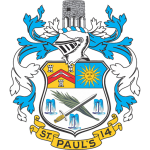
“Newport, January 1st A..L..5816, A.D. 1816, a number of the members of St. John’s Lodge No. 1, Newport, having often expressed a desire to establish a new Lodge in this town, thinking it for the benefit of Masonry in general and of this place in particular, agreed to assemble and endeavor to obtain a Charter or Dispensation for this purpose: therefore, on the second of January 1816, They assembled at the house of Jeremiah Bliss for the purpose of devising the best possible means of preserving the reputation of the institution unsullied, and promoting the interests of the Masonry.”
According to these minutes of the first organization meeting on January 2, 1816, the members again met at the home of Brother Bliss to continue their plans. It was unanimously voted that they petition St. John’s Lodge for permission to withdraw from that Lodge, and it was voted that the new lodge would be named St. Paul’s Lodge No. 14
This petition was presented to Saint John’s Lodge No. 1 of Newport on January 7 and to the Most Worshipful William Wilkinson, Esq., Grand Master of the Grand Lodge of Rhode Island, on January 8, 1816. The petition to St. John’s Lodge was approved on January 8th and it permitted St. Paul’s Lodge to meet in St. John’s Lodge forever, free of expense.
The Dispensation to establish a new Lodge was granted on January 13th by Deputy Grand Master John L. Boss and approved by Most Worshipful Grand Master William Wilkinson in Providence on January 29, 1816. The Charter was not received until October 23, 1817.
Most of the men on the roles were highly successful businessmen in Newport and along with others who either became affiliated with St. Paul’s or were initiated into the Lodge, left their marks on the town. Names such as Coggeshall, Chase, Hazard, and those mentioned before can be recognized in the names of streets, schools, wharves, and beaches. Other well known names in Newport are Lawton,Easton, Clark, and Thurston.
Although St. Paul’s Lodge met often in special communications for the purpose of conferring degrees on new members, things were not going too well. It seems that almost from teh start there was some kind of misunderstanding between St. John’s Lodge and St. Paul’s Lodge. St. Paul’s tried unsuccessfully to get the Grand Lodge to meet with representatives of the two Lodges to help straighten out their problems. So, on August 29, 1818, 2 years, 7 months, and 7 days after trying it on their own, St. Paul’s returned their charter to the Grand Lodge and reaffiliated with St. John’s Lodge No. 1 of Newport.On May 15, 1876, almost 58 years later, the Grand Loge of Rhode Island again granted a charter to St. Paul’s Lodge No. 14. The names on the roster of the new Lodge bear a striking resemblance to those of the old, indicating that the spirit that enticed the fathers to pull away from St. John’s Lodge was passed on to the sons.
St. Paul’s Lodge is too young to have been involved in the Revolutionary War, although some of its members under its first charter may have taken part while they were members of another Lodge or before they joined St. Paul’s. However in defending the liberty won in that war, St. Paul’s has been well represented. It would be impossible to list the veterans of the many conflicts, but there is one member of St. Paul’s that many of us still remember. He was raised in St. Paul’s Lodge in 1923 while a young army officer stationed at Fort Adams. He later joined the Army Air Corps and then became an Air Force General. After World War II, he was appointed Commander of the North Atlantic Treaty Organization (NATO). He is General Lyman L. Lemnitzer, USAF, retired (Aug. 29, 1899-Nov. 12, 1988)
St. Pauls’ has produced one Grand Master, Most Worshipful Brother George F. Ward.